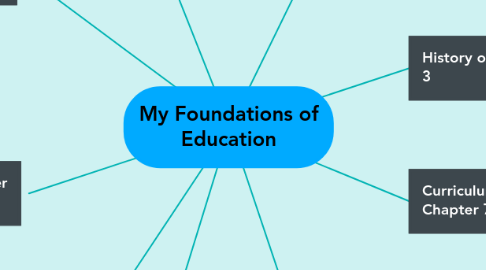
1. Sociological Perspectives Chapter 4
1.1. The Theoretical Perspective between school and society
1.1.1. Functionalism-functionalists view society as a machine where one part works with the other to produce the work that makes society work.
1.1.2. Conflict Theory-a theory that convinces students and teachers that the education system encourage learning and that sort students by their skills; not social status.
1.1.3. Interactionalism-they try to make the commonplace strange by turning on their heads everyday moments between students and students, and between students and teachers.
1.2. The 5 effects of schooling that impacts students and their future
1.2.1. 1. Employment
1.2.2. 2. Knowledge
1.2.3. 3. Teachers behavior
1.2.4. 4. Friend groups
1.2.5. 5. Gender
2. Philosophy of Education Chapter 5
2.1. Pragmatism-American philosophy founded by George Peirce, Williams James, and John Dewey. It comes from the greek word pragma which means work. This philosophy encourages people to find processes that'll help you reach your ultimate goals.
2.2. Existentalism- a modern philosophy thought of by Soren Kierkegaard. This philosophy believes that people are placed on this earth alone and must decide why things happen the way they do. To make their own sense or decide their own purpose.
3. Schools as Organizations Chapter 6
3.1. UNABLE TO FIND MY DISTRICTS CORRECT UPDATED INFORMATION. I APOLOGIZE ABOUT THIS MISSING ASPECT.
4. Equality of Opportunity Chapter 8
4.1. How does class, race, and gender affect educational outcomes? Often, people that come from a lower class family do not have family members with a college education. Therefore, they are likely to not pursue a higher education as well.Race and class go hand in hand. There's a link between race and drop out rates. 16-24 year old white students have a drop out rate of 5.2%, where as African American students have a 9.3% chance of dropping out, and finally Hispanic students have a 17.6% chance of dropping out. Normally, gender has a direct correlation between educational attainment. Women are normally better students than men, however are less likely to receive the same level of education. Females are less likely than men to quit school and are more likely to have a higher reading level. However, men excel in math compared to women. Overall, men are more likely to score higher on the SAT than women.
4.1.1. 2 responses from the Coleman Study of 1982- One response was that private school students outperform public school students in every subject almost every time by a wide margin. Another response was that a students learning experience is affected by choosing a private or public school. Private schools demand more from their students studies as well as providing a better learning environment and discipline.
5. Educational Reform Chapter 10
5.1. 2 school based reforms-1. Charter Schools-these are public schools that are free from many of the regulations applied to traditional public schools, and in return are accountable for student's performance. 2.Vouchers-a certificate of government funding for a student at a school chosen by the student or their family.
5.2. Two societal, economic, community, or political reforms- 1. No Child Left Behind- this reform provides money for extra educational services for poor children for improvements in their academic progress. 2. Race to the Top-this reform provided a grant of over 4 billion dollars to provide a reward and innovation for k-12 state and local districts.
6. Politics of Education Chapter 2
6.1. FOUR PURPOSES OF EDUCATION:
6.1.1. 1. Intellectual-to learn basic cognitive skills
6.1.2. 2. polotical-to inculcate political order
6.1.3. 3. social-to help solve social problems
6.1.4. 4. economic-to prepare students for the work force
6.2. The Role of the School Perspective
6.2.1. Conservative Perspective-They see the role of the school as providing the proper education so that the most gifted students will be able to succeed. They also believe schools socialize children into their adult role to social order can be maintained.
7. History of U.S. Education Chapter 3
7.1. The reform movement for free public education was led by Horace Mann in the early to mid 1800's.
7.2. The Democratic-Liberal school believed the U.S. education system involved the progressive evolution of a school system to provide equal opportunities for all.
8. Curriculum and Pedagogy Chapter 7
8.1. Developmentalist-This theory states that the "needs and interests" of the students are more important than that of society.
8.1.1. The Mimetic Tradition-This is based in the perspective that the intention of education is to give students specific knowledge.
8.1.1.1. The Transformative-this tradition believes that students should be transformed by education in a meaningful way, such as intellectual,spiritual,emotionally, and creatively.

